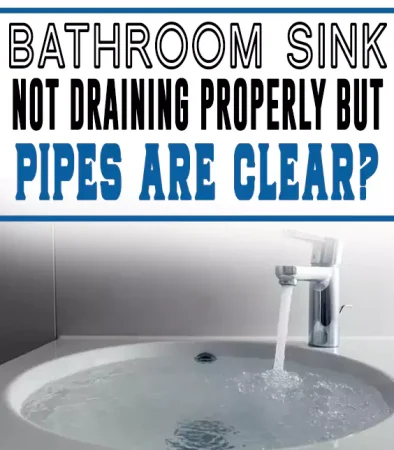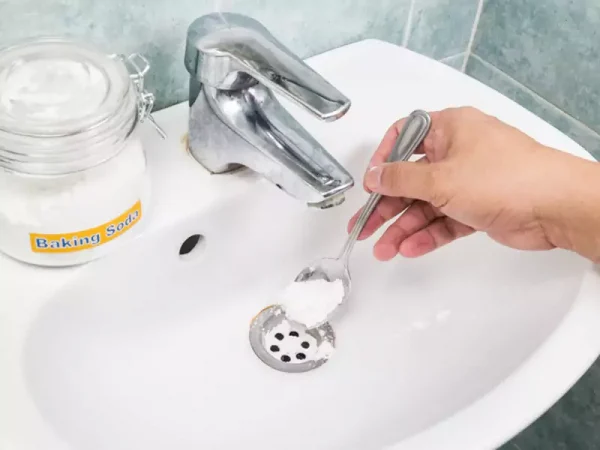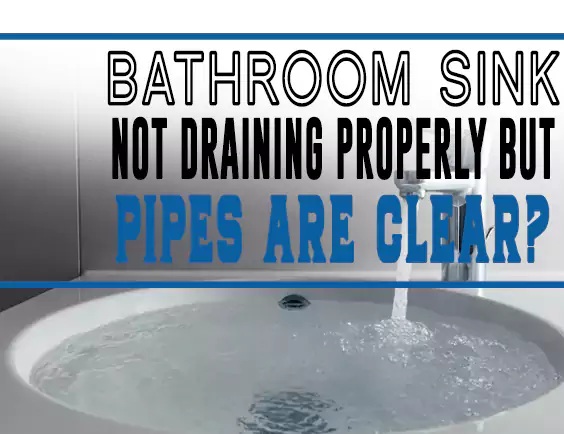Bathroom sink not draining properly? Clear pipes? There could be a few reasons for this, and in order to diagnose the issue and correct it, you will need to take a closer look at the plumbing system.
If you are experiencing the bathroom sink not draining properly but the pipes appear to be clear, there may be a blockage in the drain. This can happen if there is a build-up of soap, hair, or other debris over time.
If left unchecked, this can eventually cause wastewater to back up and flood your bathroom sink. It also causes foul odors to build up in the bathroom.
It’s important to remember that even if the water appears to be going straight down the drain, there may be some debris like candle wax or obstruction in the pipes that are causing the problem.
If you can’t see anything obstructing the pipes or if the water is gushing out like a geyser, it’s likely that there is something blocking the drain.
Recommended Reading: What to Do If Drain Water Coming Back Up Bathroom Sink
In this article, I’ll share the ways to fix a bathroom sink that is not draining properly but its pipes are clear.
3 Common Causes of Bathroom Sink That is Not Clogged But Won’t Drain

1. The Bathroom Sink Stopper
This is the first and most common cause of a bathroom sink that is not clogged but still won’t drain. The bathroom sink stopper is the first point of contact for our hair, grime, aftershave, and everything we do in our sink.
These objects can quickly block the bathroom sink stopper and cause the bathroom sink not to drain.
Solution:
Remove the drain guard on your sink, and clean out the debris it has collected. Rinse the sink stopper thoroughly with hot water or with a baking soda and vinegar solution.
Repeat the hot water rinse every time you use the sink to prevent future build-ups. Don’t use hot water if you are working with PVCs. Otherwise, they might get damaged.
2. P-Trap Problems
A clogged P-trap is the second cause of a bathroom sink that is not clogged but won’t drain. Your P-trap is responsible for trapping debris that has been drained from the sink, and it stops the formation of a deep clog within your plumbing system.
Unfortunately, the P-trap itself can become clogged and cause a sink not to drain even though its pipes are clear. This is because dirt and debris can build up in the bend of your P-trap and block it.
Solution:
Close all taps. Then remove the P-trap. This should be easy if the nuts are not too tight. If they are too tight, then you would need a plier.
Once you have removed the P-trap, remove any debris that is clogging it. Use a flexible wire brush to push out all the debris. Rinse the wire brush and repeat the process until the P-trap is clear.
Once you’re done, you can fix the P-trap back in place.
3. Faulty Plumbing
The third reason why your bathroom sink is not clogged but won’t drain is because of faulty plumbing. You see, there are many pipes in your plumbing system, and many of them play a crucial role in draining water from your sink.
Once they become damaged or start leaking, the sink stops draining even when the pipes are clear. The problem will worsen if the pipe(s) are not immediately fixed, as the sink that’s not draining will lead to more blockages in the plumbing system.
Solution:
Get a plumber to do a proper maintenance check on your entire bathroom sink system. The plumber should check for leakages, blocks, and other issues that might cause your bathroom sink not to drain.
The plumber should fix any issues found so that the problem doesn’t spread to other parts of your sink drain.
You can search for the faulty pipes in your plumbing system yourself. But be careful not to damage anything. If you don’t know how to go about it, you better stick with a professional plumber.
Important Guide: How to Seal a Bathroom Sink Drain? Silicone Caulk vs. Plumber’s Putty
4 Reasons for Bathroom Sink Not Draining But Pipes Clear
Reason 1: Build-up of sludge in the sink drain
Hair often blocks the sink drain which causes water to not drain even though the pipes are clear.
Solution 1: Clean the sink drain
Step 1: Remove the stopper
Try to remove the stopper. If it doesn’t come out quickly, look for a pivot rod nut on the drain pipe. The pivot rod nut should be right under the sink.
Step 2: Gently unscrew the nut
The next step is to unscrew the nut and detach the pivot rod from it. Pulling out the stopper should be accessible once you have removed the pivot rod.
Step 3: Remove hair and other gunk
Get a piece of metal or plastic to remove the hair and other debris. Once you have removed the gunk, fix the stopper back in its place if you didn’t remove the pivot rod.
Step 4: Fix the pivot rod and screw it in place
Take the stopper and fix it back in its place. Then gently reinsert the rod, making sure to check that the rod is properly aligned with the hole in the stopper. Fix it back in place and screw the nut back tightly.
Step 5: Run hot water down the drain
The last thing to do is to clear out any remaining gunk. Just pour hot water down the drain. Also, make sure to check the pivot rod nut for any leakages. If you find any, fasten the nut with pliers.
Solution 2: Use a Pipe Snake
Another good solution to try if your bathroom sink is not draining is using the pipe snake. A pipe snake is simply a piece of cable that can unclog blockages that is farther down the system.
Step 1: Removing the P-Trap
Locate your p-trap. It should be between your stub out and your basin. Keep a small bucket beside you so you can catch any excess water or slush. Clean the P-trap if it’s very dirty.
Step 2: Put the pipe snake into the stub
Once you’re done with the previous step, get your pipe snake and gently put it down through the drain. Don’t use too much force, or you might push the blockage deeper down the pipe. Once the snake comes up against an obstruction, then you are ready for the next step.
Step 3: Bend the snake around to unsettle the blockage
Take the snake and turn it around so it dislodges the blockage. Then pull out the snake so it can remove the debris on its way out. If the blockage is a bit stubborn, try to hook onto it with the snake pipe. Keep removing as much debris as you can until you feel like the pipe is no longer blocked.
Step 4: Fix back your P-trap
Once you’re sure the pipe is unclogged, take the P-trap and reassemble it. Tighten it well and ensure that it is watertight.
Step 5: Check whether the drain is still clogged
Rundown water to make sure the drain is no longer clogged. Using hot water helps to remove any remaining dirt or debris.
If your bathroom sink won’t drain after snaking, the problem might come from the U-bend.
Solution 3: Clear the U-bend
The u-bend is a curved bit of drainpipe under your basin. Food remnants can accumulate in the U-bend and block it. This, in turn, causes your basing to drain slowly.
Step 1: Unfasten the P-trap connectors
The first step is to locate the slip nut on the ends of the p-trap. The slip nut is what holds the P-trap to the drain pipe. Once you have found it, unscrew the nut.
Step 2: Detach the P-trap and clear all the debris
Next up is to gently remove the P-trap, which should show you the pipe. Clear all the dirt and debris that’s causing the blockage. Make sure you have your hand gloves on. Also, keep a bucket nearby, along with some cloth towels, so that you can catch excess water and debris.
Step 3: Re-assemble the P-trap
Now that the pipes are clear. You are ready to reassemble the pipes and the P-trap. Tighten the connectors with your hand. Don’t overdo the tightening; otherwise, the pipes will crack.
Step 4: Check to make sure the drain is no longer blocked
After tightening the P-trap connectors, make sure that the drain is now working properly. Rundown some hot water and see if it drains properly. Also, make sure you check for any leakages and tighten the connectors properly.
The problem might be coming from elsewhere if the sink won’t drain after cleaning your p-trap.
Solution 4: Using a plunger
Another great option to try is using a flat-bottomed plunger. It might shock you that in this method, you will unclog a sink with standing water.
Step 1: Seal the overflow
Use an appropriate material to seal the overflow. This can be a piece of cloth.
Step 2: Pour hot water into the basin
Get some hot water and pour it into your basin until the basin is half-full. This way, the water creates a nice seal around the plughole.
Step 3: Put the plunger over the drain hole
Put the plunger over the hole and start plunging away. Make sure there’s enough water in the basin to create the right amount of pressure. Do this step very thoroughly to make sure the blockage get’s cleared.
Step 4: Check whether it worked
After some vigorous plunging, wait and see if your effort paid off. If the water starts to drain, then you know what you’re doing is working.
Step 5: Repeat as needed
If the drain hasn’t been unblocked fully, then repeat the process over and over until the drain is cleared.
If, after multiple attempts, the drain still isn’t unblocked, then it might be time to try another solution.
Step 6: Flush with hot water
Once the drain is fully cleared, you can flush it with hot water. Using hot water removes any remaining debris and disinfects the place.
Solution 5: Clearing the sink overflow
Tools you need:
- Funnel
- A Pipe cleaner
- Boiling water
Take the funnel, put it in the opening of the overflow, and pour boiling water through it. Do this a couple of times to make sure you clear out all the debris.
Solution 6: Use a Drain Cleaner
Another good option to try is to use a drain cleaner. Remove any remaining water from the sink before you begin.
Things you’ll need:
- Liquid Dish Soap
- Baking soda
- Vinegar
Step 1: Prepare the materials
Boil the water, and add some liquid dish soap. Add half a cup of vinegar and half a cup of baking soda.
Step 2: Pour the mixture down the drain
Pour the soap water mix down the sink drain. Let the mixture sit for about one hour. Flush with boiling water
Reason 2: Tree Root Damage
Trees have roots that expand into the ground in every direction. Unfortunately, they also grow in the direction of pipes.
Of course, when they meet a pipe, they grow through it and break the pipe as a result. The pipe becomes blocked due to the tree roots’ presence and because the pipe leaks into the soil.
Solution: Cut the root and replace the pipe
Step 1: Find the tree root
You will need to dig up the soil and find the tree root that’s blocking the pipe. Call your local utility service at 811, so they can send someone to tell you what other lines are buried in the ground. Otherwise, you might damage another pipe as you look for the tree root.
Step 2: Cut the root and change the pipe
Once you have found the root, you can cut it up. Next is to replace the pipe or have a plumber do it.
Reason 3: Pipes are not installed correctly
The bathroom sink drain pipes need to be correctly aligned for your sinks to drain correctly. There are two drain pipes. One is in your sink, and it takes water outside the home. The second drain is in the wall, and it is responsible for emptying the water down the sewer.
The first drain needs to be higher than the second drain. Otherwise, gravity might stop the water from moving through the 2nd drain.
Solution: Change the pipes
Step 1: Loosen your sink
Lose all the fittings and gently take apart your sink. Expose the first drain.
Step 2: Remove the first drain with a shorter pipe
Remove the pipe on the first drain and replace it with a smaller one. The one you replace it with should be shorter, so it can be higher than the second drain pipe.
Reason 4: Not enough airflow to the pipes
The airflow to your pipes provides enough pressure to move water through them. Like pipes, vents, overflow can become clogged or blocked. They can even be damaged by winds.
Solution
Check the vents to your pipes and fix them. Unclog the overflow hole if there is a clog.
How to Prevent Future Clogs
1. Clean your sink drains once every week
You should pull out the stopper in your bathroom sink every now and then. Clear out any debris in the drain, and rinse the stopper properly before fixing it back
Also, use a bent wire to remove hair and other debris before reinserting the drain stopper.
2. Do a thorough drain flush every week
To do a complete flush, open the hot water line and fill the tub. The next step is to drain it. You can also do a mild drain by running hot water down the sink drain after every shower.
3. Use a drain cleaner once every month
Use a biodegradable drain cleaner. One that won’t corrode your pipes. Do this once every month to keep your drains clear and unclogged all year round. Make sure you don’t use chemical drain cleaners because they might damage your pipes.
4. Do a thorough deep clean for your drain once every month
A deep clean will remove debris that is much harder to reach through a simple flush. To do a deep clean, remove the over-flow plate. Next, lift the pop-up assembly up to the rocker arm. Clean out any hair, dirt, and debris. Then clean the pop-up assembly thoroughly before fixing it back.
5. Use a Drain Screen
A drain gate will keep the drain clear by stopping non-liquid materials from getting through to the drain.
This means that hair, dirt, and other forms of debris will have a much harder time getting to the drain.
Clean the drain screen regularly. Otherwise, it can get your bathroom sink clogged with hair.
6. Clear out hair and debris from your drain stopper
Don’t wait until the drain becomes clogged before you clear out debris. It’s even better to clean out hair and other dirt buildups from your drain stoppers before it clogs the drain.
Doing this once or twice a week will ensure that your drain stays clear and unclogged.
How to Fix a Slow Draining Bathroom Sink That is Not Clogged

Step 1: Remove the stopper
Some basins will come with sinks that make it easy to remove the stopper, while others will not. If you can lift the stopper without removing anything else, go ahead. However, some people will need to remove the pivot rod first.
Step 2: Removing the pivot rod
If you can’t just lift the stopper out like that, no problem. Just find the pivot rod nut and unscrew it. Use your hands or a set of pliers. Once you have unscrewed it, then remove the stopper. You are now ready for the next.
Step 3: Clean out the debris
If you are lucky, the debris might be stuck to the stopper. In which case, all you would need to do is clean the stopper thoroughly. Do this over a trash can to avoid spilling it all over the place.
If you aren’t so lucky, the debris will have accumulated around the pivot rod. In this case, clearing the gunk won’t be so straightforward.
You need a wire that you can bend into a hook. Once you’ve done that, use the wire to get all the debris out.
Use it as a fishing hook and pull out all the debris.
Step 4: Fix the stopper back into place
Get the stopper and put it back in place. Make sure it is well aligned before you screw the pivot rod back into the sink drain. Make sure the connection is tight enough to prevent leakages.
Step 5: Clear any remaining gunk
Use boiling water and flush out any remaining gunk. Don’t use boiling water if the pipes are made of PVC. Otherwise, the boiling water will damage the sink.
Step 6: Test out the sink
Open the tap, run some water through it, and see if the sink is draining properly. If the water is still draining slowly, it might be a sign of another blockage somewhere.
Conclusion
There are many reasons why a bathroom sink won’t drain even when the pipes are clear. The most common causes include small blockages in the p-trap, bathroom sink stopper, and sink overflow.
The best solutions I’ve used include cleaning out the bathroom sink stopper, using a pipe snake, cleaning the p-trap, etc.
I also clear out hair and debris from the drain stopper and do a thorough deep clean for my drain once every month. Otherwise, they will cause the bathroom sink not to drain even when the pipes are clear.

